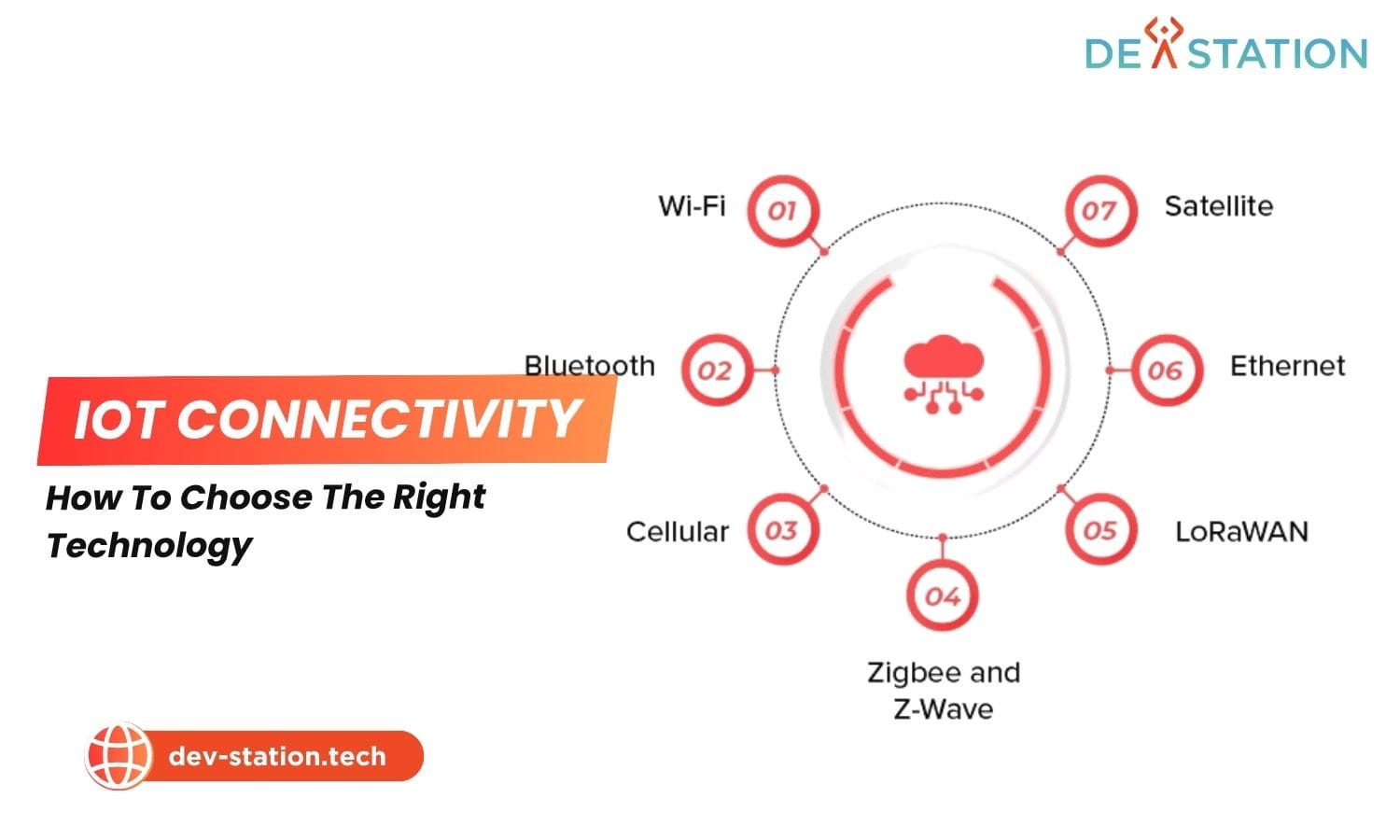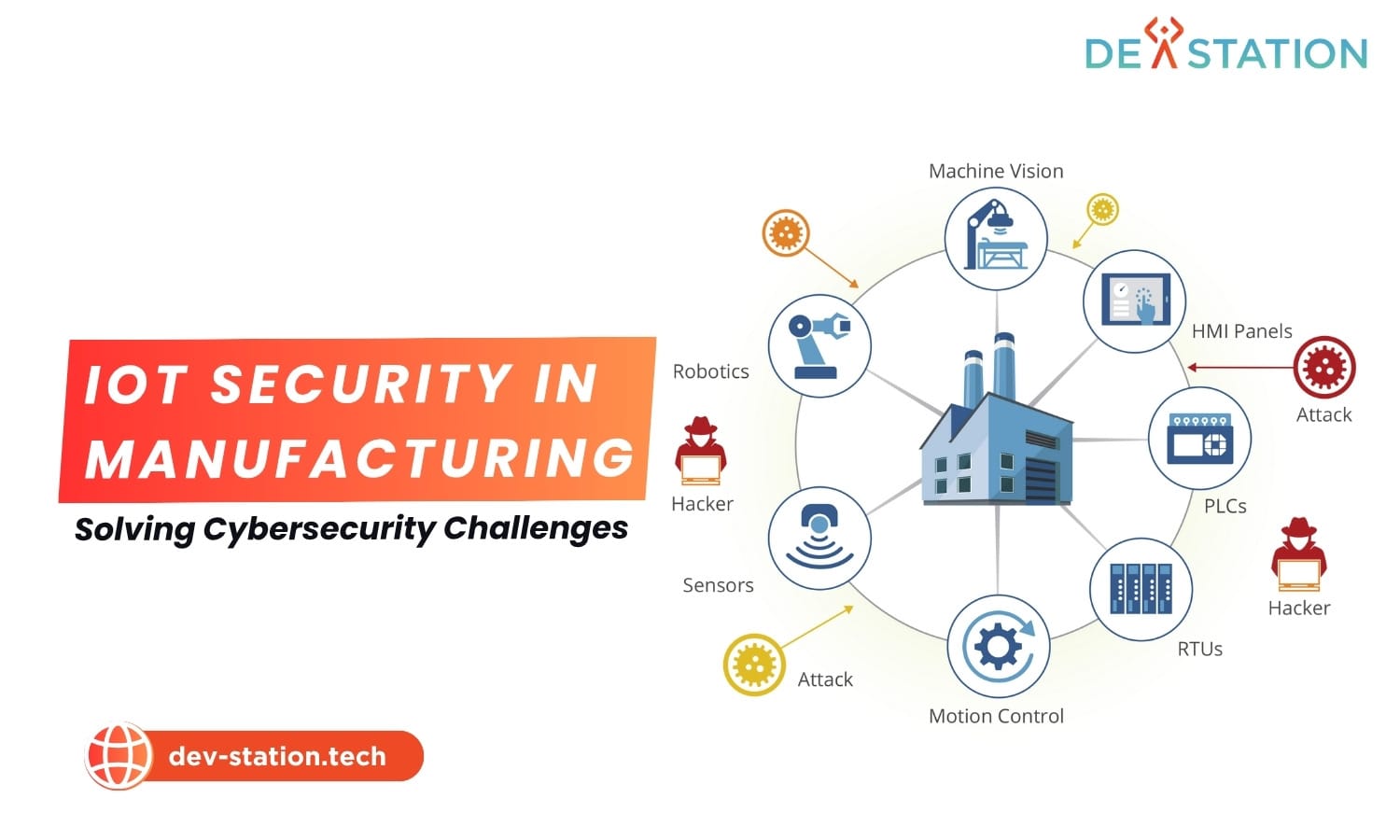IoT connectivity options deliver the essential network layer for your devices, but selecting the optimal one requires a strategic approach to balance performance and cost, a challenge Dev Station Technology helps businesses solve. We provide the expertise to navigate the complex landscape of communication links, ensuring your solution is built on a solid foundation for success with the right network protocols and IoT architecture.
Contents
ToggleWhat Are The Top IoT Connectivity Technologies To Consider?
The most prominent IoT connectivity technologies include Wi-Fi for high-speed local networks, Bluetooth for short-range personal devices, LPWANs like LoRaWAN and NB-IoT for long-range low-power applications, and Cellular networks for reliable, wide-area coverage.
Choosing the right communication method is the cornerstone of any successful Internet of Things deployment. Each technology offers a unique combination of features, and understanding their strengths and weaknesses is critical for your project’s performance and financial viability. The landscape of connected device technology is vast, but it can be broadly categorized into a few key groups. Dev Station Technology helps clients navigate these options to find the perfect fit.
Here is a detailed comparison of the leading wireless IoT technologies you should evaluate for your next project.
| Technology | Best For | Key Advantage |
|---|---|---|
| Wi-Fi | Smart homes, offices, and indoor asset tracking. | High bandwidth and existing infrastructure. |
| Bluetooth & BLE | Wearables, smart peripherals, and proximity marketing. | Extremely low power and low cost. |
| LPWAN (LoRaWAN, Sigfox) | Smart agriculture, smart cities, and remote monitoring. | Very long range and exceptional battery life. |
| Cellular IoT (LTE-M, NB-IoT, 5G) | Fleet management, connected vehicles, and mobile assets. | Reliable, secure, and extensive global coverage. |
How Do You Choose The Right IoT Connectivity?
To choose the right IoT networking solution, you must analyze five critical factors for your specific use case: the required communication range, the necessary data bandwidth, the device’s power consumption limits, the total cost of hardware and data, and the level of security required.
Selecting an IoT communication technology is not about finding the single best option, but about finding the most appropriate option for your application. A solution perfect for a smart home hub will fail spectacularly for a remote agricultural sensor. A careful analysis of your project requirements is the only way to ensure you make a choice that is both technically sound and commercially viable. Below, we break down the five essential factors to guide your decision-making process.
What Is The Required Range For Your IoT Device?
The required range is the physical distance over which your IoT device needs to transmit data. This can vary from a few meters for personal devices to many kilometers for remote industrial or agricultural sensors.
The operational range of your device is the first and most fundamental filter in your selection process. If the technology cannot cover the required distance, it is immediately disqualified. IoT network solutions are often categorized by their effective range.
- Short-Range (Under 100 meters): Technologies like Bluetooth, BLE, and Zigbee are ideal for Personal Area Networks (PAN) and Local Area Networks (LAN). A smart watch connecting to a phone is a classic example. Similarly, smart lighting inside a single building benefits from these low-power, short-range options.
- Medium-Range (Up to a few hundred meters): Wi-Fi is the dominant technology in this category. It is perfect for smart homes, offices, and factory floors where you have consistent access to routers and a need for higher data throughput. Wi-Fi 6 (802.11ax) is enhancing capabilities for dense IoT environments, improving how many devices can operate reliably in one area.
- Long-Range (Over 1 kilometer): This is the domain of Low-Power Wide-Area Networks (LPWAN) and cellular technologies. LPWANs like LoRaWAN can achieve ranges of 5 to 15 kilometers in rural environments, making them perfect for smart agriculture. Cellular technologies like LTE-M and 5G provide reliable connectivity over vast national and international networks, essential for logistics and asset tracking.
How Much Bandwidth Does Your Application Need?
Bandwidth is the capacity of the network to transmit data, typically measured in bits per second (bps). Your application may need very low bandwidth for simple sensor readings or very high bandwidth for video streaming.
The amount of data you need to send, and how often you need to send it, determines your bandwidth requirements. Over-provisioning bandwidth leads to unnecessary costs, while under-provisioning will cause your application to fail. A 2023 report from IoT Analytics highlights that the majority of IoT connections are low-bandwidth, but high-bandwidth applications are growing.
- Low Bandwidth (Under 100 kbps): Most IoT use cases fall into this category. A soil moisture sensor, a smart utility meter, or a simple location tracker only need to send a few bytes of data periodically. For these applications, LPWAN technologies like NB-IoT (offering around 20-250 kbps) and LoRaWAN (offering 0.3-50 kbps) are highly efficient and cost-effective.
- Medium Bandwidth (100 kbps to 10 Mbps): This range is suitable for more complex sensor data, firmware updates, or voice commands. Technologies like LTE-M (offering up to 1 Mbps) and older cellular standards are a good fit here. They provide a balance between data rate, power consumption, and cost.
- High Bandwidth (Over 10 Mbps): Applications that require real-time video streaming, such as security cameras or in-vehicle infotainment systems, demand high bandwidth. Wi-Fi (offering hundreds of Mbps) and 5G (offering multi-Gbps) are the primary choices for these demanding use cases.
What Are The Power Consumption Constraints?
Power consumption determines how long your device can operate on its battery. For devices in remote locations without access to a power grid, optimizing for ultra-low power consumption is a primary design goal.
For a significant portion of IoT devices, battery life is not just a feature; it is the single most critical factor for feasibility. If a remote sensor needs its battery replaced every few weeks, the operational cost becomes prohibitive. The goal for many applications is a battery life of 5 to 10 years.
- Ultra-Low Power: Technologies designed from the ground up for minimal power draw include BLE, LoRaWAN, and NB-IoT. They achieve this through features like deep-sleep modes, where the device powers down most of its components and only wakes up to transmit data. A LoRaWAN sensor, for example, might only be active for less than 1% of the day, allowing it to last for years on a small battery.
- Medium Power: LTE-M offers a compromise, providing higher bandwidth than NB-IoT but with higher power consumption. It includes Power Saving Mode (PSM) and extended Discontinuous Reception (eDRX) to conserve energy, but it is not as efficient as true LPWANs.
- High Power: Wi-Fi and standard 5G are power-hungry due to their high data rates and complex protocols. They are suitable only for devices with a constant power source, such as a smart TV, a gateway, or a connected car.
What Is Your Budget For Hardware and Data?
The total cost of ownership (TCO) for IoT connectivity includes the upfront cost of the communication module in the hardware and the recurring operational cost of data plans or network access fees.
A comprehensive cost analysis must look beyond the initial hardware. For large-scale deployments, recurring data subscription costs can quickly eclipse the initial hardware investment. The choice of licensed versus unlicensed spectrum plays a major role here.
- Hardware (Module) Cost: Bluetooth and Wi-Fi modules are generally the cheapest, often costing less than $2 per unit. LPWAN modules like LoRaWAN are slightly more, typically in the $5-$10 range. Cellular modules are the most expensive, with LTE-M and NB-IoT modules costing between $10 and $20, and 5G modules costing significantly more.
- Data (Subscription) Cost: Technologies operating in unlicensed spectrum, like Wi-Fi, Bluetooth, and LoRaWAN (if you build your own network), have no direct data costs. However, you are responsible for building and maintaining the network infrastructure. Technologies operating in licensed spectrum, like cellular iot telecom networks, require a data plan. These plans are often very cheap for low-data devices, with some providers offering plans for less than $1 per device per month.
How Critical Is Security For Your IoT Solution?
IoT security involves protecting the device, the network, and the data from unauthorized access and cyber threats. The level of security required depends on the sensitivity of the data and the potential impact of a breach.
Security cannot be an afterthought in IoT design. Every connected device is a potential entry point for an attack. While all modern communication protocols offer some level of encryption, some are inherently more secure than others.
- High Security: Cellular networks are generally considered the most secure option. They benefit from SIM-based authentication, established network-level security protocols, and management by professional telecom operators. This makes cellular the preferred choice for applications handling sensitive data, like financial transactions or healthcare information.
- Moderate Security: Wi-Fi security is robust when properly configured with WPA3, but it relies on the user setting strong passwords and keeping router firmware updated. LoRaWAN has strong end-to-end AES-128 encryption at the network and application layers.
- Lower Security: Bluetooth security has improved, but older versions have known vulnerabilities. Its short range is a mitigating factor, as an attacker must be physically close. For any IoT deployment, security must be implemented in layers, from the device hardware itself to the application in the cloud.
How Can Dev Station Technology Guide Your Connectivity Choice?
Dev Station Technology provides expert IoT consulting services to help you analyze these five factors, select the optimal technology, and design a scalable and secure IoT architecture for your business.
Making the right IoT connectivity decision is a complex process with long-term consequences for your product’s performance, scalability, and profitability. The trade-offs are not always obvious, and a wrong choice early in the design phase can lead to costly redesigns or a failed deployment.
At Dev Station Technology, our team of IoT experts has guided numerous companies through this critical selection process. We work with you to understand your specific business case, technical requirements, and budget constraints. Our process involves:
- Deep Dive Requirements Analysis: We go beyond the surface to understand your true needs for range, data throughput, power, cost, and security.
- Technology Evaluation: We provide an unbiased comparison of the most suitable technologies, presenting the pros and cons of each in the context of your project.
- Proof of Concept (PoC) Development: We can help you build a PoC to test the chosen technology in a real-world environment before committing to a full-scale deployment.
- Provider Sourcing: We can assist in finding and negotiating with network providers and hardware vendors to ensure you get the best service and pricing.
Do not leave your project’s success to chance. Let us help you build a connected solution that is efficient, reliable, and built for the future. To learn more about how we can assist with your IoT strategy and development, please visit us at Dev Station Technology or contact our team directly for a consultation at sale@dev-station.tech. Explore more of our insights and solutions at dev-station.tech.





